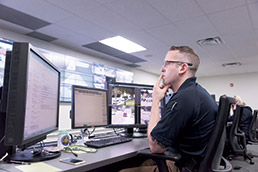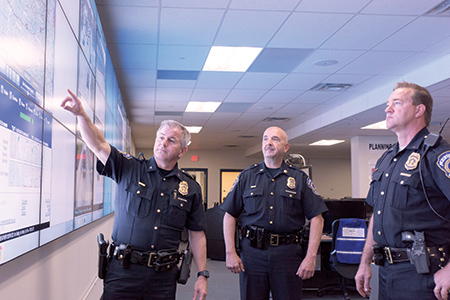Subscriber Benefit
As a subscriber you can listen to articles at work, in the car, or while you work out. Subscribe NowThe Indianapolis Metropolitan Police Department wants to use data to help anticipate and prevent crime.
City leaders believe transportation data could help connect affordable groceries to people without access to fresh food.
A local water technology firm is trying to leverage sensors and software to improve distribution of the city’s drinking water and reduce the number of water-main breaks.
These are the first projects Indianapolis is tackling as it seeks to become a “smart city,” a concept taking off nationally as communities try to find new ways to use data and technology to solve problems and make government more efficient.
Indianapolis has the potential to become a leader in smart-cities projects, officials said. And it recently won a grant competition from the Virginia-based Smart Cities Council that will give leaders the tools and expertise to scale up their efforts.
“Indianapolis is really good at taking a vision that’s aspirational and meeting it,” said former Mayor Stephen Goldsmith, director of the Innovations in American Government Program at Harvard University’s Kennedy School of Government. “Think amateur sports.
“What we haven’t quite done is paint a picture of how important this [goal] is to the future positioning of the city,” Goldsmith said. “Once that’s accomplished and the case is made, Indianapolis always responds. This is the future.”
But the city is already behind some competitors. As Indianapolis starts learning what it means to be a smart city, other midsize metro areas—including Columbus, Ohio; Kansas City, Missouri; and San Diego—are moving at breakneck speed.
“It’s not just a trend; it’s a race,” said Jesse Berst, founder and chairman of the Smart Cities Council, which bills itself as a network of companies, universities and other bodies that acts as a “neutral adviser” to cities.
“There’s fierce competition for early research and jobs,” Berst said. “There’s some major economic development benefits, but also environmental benefits. You’re going to have a better time if you get in the race early.”
What makes a city smart? Depends on whom you ask.
The Smart Cities Council describes a smart city as having “digital technology embedded across all city functions” but admits the concept is still in the “know-it-when-I-see-it” phase. Others describe it as building “intelligent infrastructure.”
Regardless of the definition, capitalizing on the data a community already has—and tearing down barriers so it can be shared among departments and examined in different ways—is a big part of the concept.
“The data is where the gold is,” Berst said.
The concept is manifesting itself differently across the country.
Columbus—2016 winner of the U.S. Department of Transportation’s Smart Cities challenge—has more than $400 million in public and private resources to invest in intelligent transportation systems, including streetlights that are hubs for wireless internet connection, driverless shuttles, electric-vehicle charging, and parking-management services.
San Diego has deployed 3,200 sensors on its streetlights, allowing them to direct drivers into open parking spaces, help police during emergencies, track carbon emissions and more.
Kansas City is investing $15 million in a partnership with Cisco Systems Inc. to make a two-mile downtown corridor smarter, complete with kiosks for people to learn about transportation, entertainment and city services—and to receive emergency alerts.
Indianapolis is just starting to define the concept for itself.
Ken Clark, the city’s chief information officer, said projects are being judged based on how well they can strengthen neighborhoods, reduce poverty and help the city with fiscal solvency.
“It’s not about every light doing something cool,” Clark said, but is instead “about how we can help people who need help in a way that’s valuable to them. Making public safety and poverty reduction the centerpiece of it is the ideal.”
Indianapolis has roots in deploying the concept in lower-tech ways, Goldsmith said, but an explosion of connected devices and new tools for crunching data has opened up much more potential.
When Goldsmith was a prosecutor in Indianapolis, he said, his team used data to increase child support collections. And Indianapolis was a trailblazer in creating a website through which residents could take care of basic services.
But, “from a city hall perspective, the last five years have been almost breathless,” he added. “You have mobile tools available. Cloud computing. Sensors.”
Meanwhile, other Indiana cities are making progress, too. South Bend Mayor Pete Buttigieg made headlines in 2015 when that city upgraded its sewer system with $6 million worth of sensors and controls that allowed it to avoid a $100 million repair.
And the state is also hoping to make inroads in capitalizing on the power of big data. This year, the Indiana General Assembly codified the state’s “management and performance hub” as a state agency and funded it at $9 million per year.
The hub seeks to analyze various public data sets to enrich public-policy debates and help solve problems. Two big challenges officials are already tackling: reducing Indiana’s infant-mortality rate and checking its opioid epidemic.
“It’s not data for data’s sake,” said Mark Lawrance, Indiana Chamber of Commerce vice president. “It’s data to help improve things. The potential is great.”
Leaders say Indianapolis’ reputation for cooperation among government, the private sector and philanthropy increases its potential to lead in the smart-city field.
Goldsmith said the city’s big convention population is another asset. He imagines an “even more exciting” downtown experience in which visitors are greeted with digital signage and way-finding tools, receive a mobile alert about a special exhibit while visiting a museum, or have an app route them to the closest open parking space.
The biggest challenge keeping Indianapolis from moving faster in smart-cities technology is funding, city leaders say. Mayor Joe Hogsett, known for his frugality, is still wrestling with the city’s roughly $25 million budget deficit.
“We dream outside of our budget,” said Katie Robinson, director of the Office of Sustainability.
So city officials say they’re trying to focus on projects that will have the most impact, while realizing the effort is long term.
Here’s how Indianapolis and its partners are employing smart technology and envisioning more uses.
 The IMPD’s Real Time Data Center, located in the former Eastgate shopping center, was developed for the Super Bowl in 2012 but is now used for day-to-day operations. (IBJ photo/Eric Learned)
The IMPD’s Real Time Data Center, located in the former Eastgate shopping center, was developed for the Super Bowl in 2012 but is now used for day-to-day operations. (IBJ photo/Eric Learned)Public safety
Police have gathered and employed data for decades, but the Indianapolis Metropolitan Police Department is now making it work in a whole new way, with “predictive policing.”
For example, traditionally after a shooting, a uniformed officer takes a report and an investigative unit comes to the scene to interview witnesses and victims, then develops a reactive case, said IMPD Deputy Chief of Operations Chad Knecht.
But now IMPD is trying to predict the next shooting—maybe a revenge crime—before it happens. At IMPD’s real-time data center, police are crunching data from security cameras and license-plate readers to make links and analyze “everyone that runs around with the victim, suspect, what cars they’ve been known to be in, what crimes they’ve committed.”
“We can get in front of it if there are any retaliatory actions,” Knecht said. “We can go to those locations and put additional traffic stops, police presence. We’re getting there before the offender and showing we are prepared to respond.”
The data center was developed in 2012 for that year’s Super Bowl in Indianapolis. But the city started using it for day-to-day policing this January.
IMPD is also using a “social-disorder index”—a measurement of the amounts and types of offenses recorded in a neighborhood—to try to prevent crimes, in part by fixing underlying problems.
For instance, police knocked on doors near East 10th and Rural streets, an area with a high social-disorder index, and asked residents what problems needed to be solved in their neighborhoods. Then, the department worked with public and social service agencies to try to resolve the concerns before they led to crimes.
Five months later, the area’s social-disorder index was down 57 percent, according to IMPD.
Additional technology could analyze data to see early on whether activity that led to major crimes in the past is starting up again.
“Instead of just being reactive, we can be proactive,” Knecht said.
Food deserts
Indianapolis’ food-desert problem has been top of mind since Hogsett took office, and the pending closure of Marsh grocery stores is exacerbating it. But smart-cities solutions could help.
The city is working with IUPUI to define the concept of a food desert specifically for Indianapolis (there’s already a federal definition). Then city officials want to look at real-time metrics for possible solutions.
One key is trying to figure out the best places to offer incentives to get a grocery store or neighborhood market up and running. And city officials think they could use mapping software and public transportation data to find better, creative ways to connect people with fresh food.
“It may not make as much of a difference that you live in a food desert as it does how you get to food,” said Hope Tribble, director of the Office of Audit and Performance.
Water infrastructure
There’s also a fledgling partnership among the city, its utilities and Global Water Technologies that hopes to transform the city’s water infrastructure.
The plan, said Global Water Technologies CEO Erik Hromadka, is to create a wireless network near the 16 Tech innovation district north of the IUPUI campus that would connect water meters, gas meters and streetlights to showcase ways to use sensor technology to solve problems, such as the city’s aging underground water infrastructure.
The proposed network, for example, could leverage connected devices—the internet of things—to help make the distribution system more efficient, improve customer service by providing better information, reduce water-main breaks, and even help with public safety, Hromadka said.
And having a system that’s connected to other utilities means potential extra help during an emergency.
“If there’s a fire run to the area, you could have a streetlight that flashes as an indicator of the location,” Hromadka said.
The Global Water Technologies project currently has no timeline or budget.
Government efficiency
The city is revamping its website as another smart-cities project, dubbed Shift Indy. But Clark said the project is not about just redesign, but also “digitizing government processes behind the scenes.”
That could mean installing kiosks and portals around the city to allow people without internet access to take care of basic government needs.
“How do we help folks who don’t have a car not to have to come here?” Clark said from the 25th floor of the City-County Building downtown. “Where we can, we’re focused on creating a digital-city-hall concept.”
The city also wants to equip its departments with management and performance data as a way to “improve processes, save money and reduce costs,” Tribble said.
The city is working with Bloomberg Philanthropies’ WhatWorksCities initiative to make that happen.
The effort could include providing departments with dashboards to display performance data in a few areas, such as calls that come into the Mayor’s Action Center phone line and interactions at the Department of Business and Neighborhood Services, formerly known as code enforcement.
“It’s not just counting widgets, like how many inspections we do, but, ‘How do we improve?’” Tribble said. “‘How do we get better outcomes in our inspections? How might we count the efficacy of those inspections and set goals?’ Maybe we can reduce the number of failures.”•
Please enable JavaScript to view this content.

